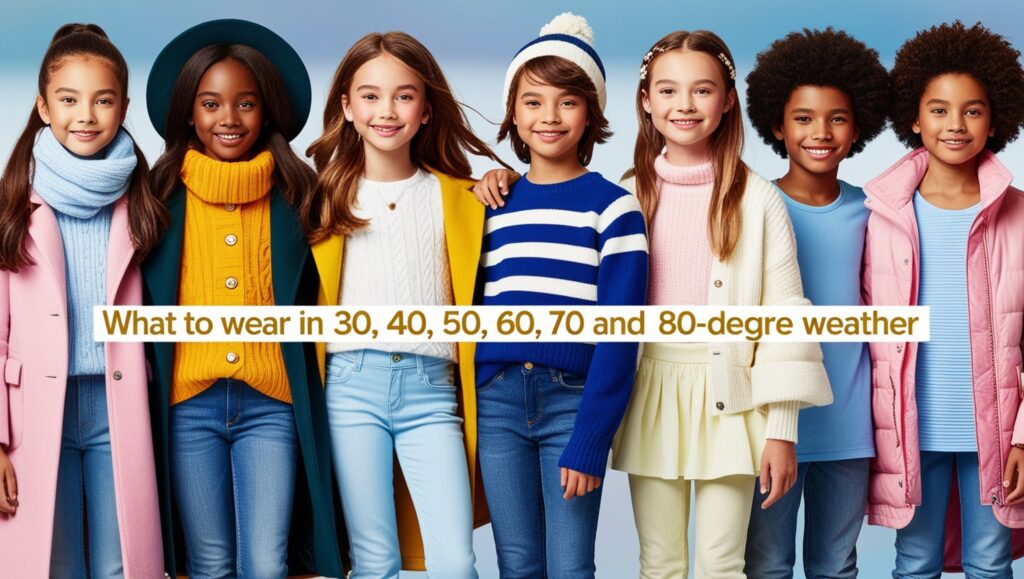
In today’s unpredictable weather, knowing what to wear in [30– 80] weather is more important than ever. Whether you’re layering up for chilly 30°F mornings or dressing light for sunny 80°F afternoons, selecting the right outfit can make all the difference in comfort, health, and style.
This guide will help you navigate the best clothing options for every temperature range, ensuring you’re always prepared no matter the weather. Discover what to wear in 30, 40, 50, 60, 70, and 80 weather and build a versatile wardrobe that keeps you ready for any conditions.
Understanding Weather and Temperature: The Foundation of Smart Dressing

Before diving into specific clothing layers for each temperature range, it’s essential to grasp the basics of weather and temperature. Climate conditions play a significant role in how we perceive temperature and, consequently, how we dress.
you should also read this Missouri Rockhounding Sites in 2024
Factors Affecting Temperature Perception
- Humidity
- Wind chill
- Sun exposure
- Elevation
- Time of day
These atmospheric conditions can significantly impact how we experience temperature. For instance, a 60°F (16°C) day might feel much cooler on a windy, overcast morning than on a sunny, calm afternoon.
Regional Variations in Weather Perception

It’s worth noting that temperature perception can vary greatly depending on your location and what you’re accustomed to. A 50°F (10°C) day might feel brisk to someone from Florida but balmy to a resident of Minnesota.
“There’s no such thing as bad weather, only unsuitable clothing.” – Alfred Wainwright
This quote underscores the importance of dressing for weather and adapting to various climate conditions.
Dressing for Freezing Temperatures: 30°F (-1°C)
When the mercury dips to 30°F, it’s time to bring out the heavy artillery of your wardrobe. The key to staying warm in freezing temperatures lies in mastering layering strategies.

The Layering Trifecta
- Base layer: This is your foundation layer, typically made of moisture-wicking materials like merino wool or synthetic fabrics. It should fit snugly against your skin to trap warmth and wick away sweat.
- Insulation layer: This middle layer provides the bulk of your warmth. Materials like fleece, down, or synthetic insulation are excellent choices.
- Outer layer: Your final layer should be wind and waterproof to protect you from the elements. A good quality waterproof jacket is essential.
Key Clothing Items for Extreme Cold
- Insulated boots: Essential for keeping your feet warm and dry.
- Thermal underwear
- Thick, warm socks (preferably wool)
- Long pants: Opt for insulated options or layer with thermal leggings underneath.
- Heavy sweater or fleece jacket
- Down or synthetic insulated coat
- Warm hat or beanie
- Insulated gloves or mittens
- Scarf or neck gaiter
Protecting Extremities
Don’t forget to pay extra attention to your hands, feet, and head, as these areas are particularly susceptible to cold. Insulated boots and warm, waterproof gloves are non-negotiable in 30°F weather.
Navigating the 40s: 40°F (4°C)

At 40°F, you’re dealing with cold, but not extreme temperatures. This is where smart layering strategies come into play.
Transitioning from Extreme Cold to Cool
While 40°F isn’t as harsh as 30°F, it’s still chilly enough to require careful consideration of your outfit layers. The goal is to stay warm without overheating.
Smart Layering Techniques
- Start with a lightweight base layer
- Add a warm mid-layer, like a fleece or light sweater
- Top it off with a wind-resistant jacket
Versatile Clothing Options for Fluctuating Temperatures

- Lightweight thermal underwear
- Long pants: Jeans or thicker trousers
- Long-sleeved shirt
- Light sweater or fleece
- Windbreaker or light jacket
- Warm socks
- Closed-toe shoes or light boots
- Light gloves and a beanie
Remember, the key to dressing for 40°F weather is flexibility. You want to be able to add or remove layers as needed throughout the day.
The Nifty Fifties: 50°F (10°C)
At 50°F, we’re entering the realm of mild temperatures. This is where balancing warmth and breathability becomes crucial.
Ideal Outfits for Spring and Fall
50°F is a common temperature during spring and fall, making it essential to master dressing for this range. Here are some outfit ideas:
- Jeans, a light sweater, and a denim jacket
- Chinos, a long-sleeved shirt, and a light cardigan
- A dress with tights and a light jacket
- Long pants with a t-shirt and a light fleece
Adapting Your Wardrobe for Indoor-Outdoor Transitions

When dressing for 50°F weather, consider that you’ll likely be moving between heated indoor spaces and cooler outdoor areas. Layering strategies are your best friend here.
- Start with a breathable base layer
- Add a light sweater or long-sleeved shirt
- Top with a light jacket or cardigan that’s easy to remove
Comfortable Sixties: 60°F (16°C)
60°F is often described as the perfect temperature. It’s warm enough to be comfortable but cool enough to avoid overheating.
Light Layering Strategies
While you won’t need heavy layers at 60°F, some light layering can still be beneficial, especially in the morning or evening when temperatures might dip.
- T-shirt or light long-sleeved shirt as a base
- Light sweater or cardigan for an extra layer if needed
Embracing Breathable Fabrics

At this temperature, breathable fabrics become increasingly important. Look for materials like:
- Cotton
- Linen
- Lightweight wool
- Moisture-wicking synthetic fabrics
These airy materials will help regulate your body temperature and keep you comfortable throughout the day.
Dressing for Unpredictable Weather
60°F can sometimes come with unpredictable weather, especially during transitional seasons. Be prepared with:
- A light, packable rain jacket
- Closed-toe shoes that can handle a light drizzle
- A light scarf or wrap for sudden breezes
The Sweet Spot: 70°F (21°C)
70°F is widely considered the ideal temperature for comfort. It’s warm enough for light clothing but not so hot that you’ll be uncomfortable.
Optimal Comfort Clothing

At 70°F, you can start to embrace more summer-like clothing:
- Short-sleeved shirts or blouses
- Light dresses or skirts
- Shorts or capris
- Light, breathable fabrics like cotton and linen
Balancing Style and Practicality
This temperature allows for a wide range of stylish options while still maintaining comfort. Here are some outfit ideas:
- A sundress with a light cardigan
- Chino shorts with a polo shirt
- A maxi skirt with a sleeveless top
- Light jeans with a t-shirt and an open button-down shirt
Outfit Ideas for Various Activities
| Activity | Outfit Suggestion |
|---|---|
| Office work | Light slacks, a blouse, and a blazer |
| Casual outing | Shorts or a skirt with a t-shirt |
| Outdoor sports | Moisture-wicking shorts and shirt |
| Evening event | A light dress or slacks with a short-sleeved shirt |
you can also read this Lapis Lazuli Value Guide: Worth, Quality & Buying Tips
Keeping Cool in the 80s: 80°F (27°C)

When the temperature hits 80°F, staying cool becomes the priority. This is where breathable fabrics and smart clothing choices really shine.
Breathable, Lightweight Fabrics
Opt for materials that allow your skin to breathe and help wick away sweat:
- Lightweight cotton
- Linen
- Bamboo
- Moisture-wicking synthetic fabrics
Sun Protection Strategies
While staying cool is important, don’t forget about sun protection. Here are some ways to incorporate UV protection into your outfit:
- Wide-brimmed hats
- Lightweight, long-sleeved shirts made from breathable fabrics
- Sunglasses with UV protection
- Loose-fitting, light-colored clothing
Staying Stylish While Beating the Heat
Just because it’s hot doesn’t mean you can’t look good. Here are some stylish outfit ideas for 80°F weather:
- A flowy sundress with sandals
- Linen shorts with a breathable tank top
- A lightweight, short-sleeved button-down shirt with chino shorts
- A breezy maxi skirt with a crop top
Remember, in hot weather, looser fits can help air circulate and keep you cooler.
Accessorizing Across Temperature Ranges

Accessories can make or break your outfit, especially when dressing for different temperatures. Here’s a guide to accessorizing across various temperature ranges:
30-40°F: Cold Weather Accessories
- Thick, insulated gloves or mittens
- Warm, knit hat or beanie
- Thick, woolen scarf
- Thermal socks
- Ear muffs or ear warmers
50-60°F: Transitional Accessories
- Light gloves
- Light scarf or wrap
- Baseball cap or light beanie
- Sunglasses (yes, even in cooler weather!)
- Lightweight, fashionable socks
70-80°F: Summer-Friendly Accessories
- Wide-brimmed sun hat
- Sunglasses with UV protection
- Light, decorative scarf (for style rather than warmth)
- Breathable, moisture-wicking socks for athletic activities
Examples of Versatile Clothing Items for Different Temperatures
Having versatile clothing items in your wardrobe can help you adapt to various temperatures. Here are some examples:
| Clothing Item | Good for (Temperature) | Use |
|---|---|---|
| Lightweight, Long-Sleeved Base Layer | 30°F to 70°F | Wear alone in mild weather or as a base layer in cold conditions |
| Fleece Jacket | 30°F to 60°F | Mid-layer in very cold weather or outer layer in cool conditions |
| Waterproof Shell Jacket | All temperatures | Protect from wind and rain in any weather |
| Convertible Pants (with Zip-Off Legs) | 50°F to 80°F | Wear as full pants in cooler weather or convert to shorts when it warms up |
| Merino Wool Sweater | 30°F to 60°F | Excellent insulating layer that works well in a range of temperatures |
| Lightweight, Quick-Dry Pants | 50°F to 80°F | Comfortable in warm weather but provide more coverage than shorts |
| Versatile Dress or Skirt (with Leggings) | 50°F to 80°F | Can be dressed up or down and adapted for different temperatures |
| Light, Packable Down Jacket | 30°F to 50°F | Excellent warmth-to-weight ratio, easy to pack when not needed |
This table format presents the information in a clear and structured way
Innovative Fabric Technologies

Advancements in textile technology have revolutionized how we dress for different temperatures. Here are some innovative fabrics to look out for:
Moisture-Wicking Materials
These fabrics draw sweat away from your body, helping to keep you dry and comfortable. Look for terms like:
- Dry-fit
- Moisture-wicking properties
- Sweat-wicking
Temperature-Regulating Fabrics

Some cutting-edge fabrics can actually help regulate your body temperature:
- Phase-change materials (PCMs): These fabrics absorb, store, and release heat for optimal thermal regulation.
- Cooling fabrics: Some materials use special weaves or chemical treatments to provide a cooling effect.
Eco-Friendly and Sustainable Options
As awareness of environmental issues grows, so does the demand for sustainable clothing options:
- Recycled polyester
- Organic cotton
- Tencel (made from wood pulp)
- Bamboo fabric
These materials often offer excellent breathable fabrics properties while being kinder to the planet.
Dressing for Specific Activities
Different activities require different approaches to dressing, even at the same temperature. Here’s a guide to dressing for various outdoor activities:
Outdoor Sports and Exercise
When engaging in outdoor sports or exercise, prioritize:
- Moisture-wicking base layers
- Breathable, flexible fabrics
- Appropriate footwear for the activity
- Sun protection (hat, sunglasses, sunscreen)
Casual vs. Formal Attire Considerations

Even in extreme temperatures, sometimes we need to dress up. Here are some tips for maintaining formality while staying comfortable:
- In cold weather, opt for wool suits and coats over synthetics
- In hot weather, look for lightweight, breathable formal wear (e.g., tropical weight wool, linen suits)
- Layer appropriately so you can adjust your outfit for indoor and outdoor settings
if you are interested you can also read this Petrified Wood Value: Find Out How Much It’s Worth
Work-Appropriate Outfits for Various Temperatures like 30 40 50 60 70 80 Weather
| Temperature | Work Outfit Suggestion |
|---|---|
| 30-40°F | Wool suit with thermal underlayers, warm coat |
| 50-60°F | Light suit or dress with a blazer |
| 70-80°F | Breathable dress shirt with light slacks or a summer dress |
The Psychology of Color in Weather-Appropriate Dressing
Believe it or not, the colors you wear can affect how you perceive temperature. Here’s a quick guide:
How Color Affects Temperature Perception
- Warm colors (red, orange, yellow) can make you feel warmer
- Cool colors (blue, green, purple) can make you feel cooler
Seasonal Color Trends
While you should wear what makes you feel good, here are some traditional seasonal color associations:
- Spring: Pastels and light, bright colors
- Summer: Vibrant, saturated colors
- Fall: Earth tones and rich, warm colors
- Winter: Deep, jewel tones and neutrals
Adapting Your Wardrobe for Climate Change

As global temperatures continue to fluctuate, having a versatile wardrobe is more important than ever.
Building a Versatile, Weather-Ready Closet
- Invest in quality layering pieces
- Choose clothes that can be dressed up or down
- Opt for fabrics that work well in multiple seasons
- Include a mix of light and heavy pieces for unpredictable weather
Investing in Quality, Multi-Functional Pieces
Some key items for a weather-adaptable wardrobe:
- A high-quality, waterproof jacket
- Versatile blazer or cardigan
- Well-fitting jeans or trousers
- Breathable, moisture-wicking base layers
- Comfortable, weather-appropriate shoes
Effectively Planning for What to Wear in [30-80] Weather
Your Wardrobe for Unpredictable Weather Changes
Planning your wardrobe for unpredictable weather requires strategy and flexibility. Here are some tips:
Master the Art of Layering
- Start with a moisture-wicking base layer
- Add an insulating mid-layer
- Finish with a weather-protective outer layer
Invest in Versatile Pieces
- Choose items that can be dressed up or down
- Opt for neutral colors that can be easily mixed and matched
Keep an Eye on Weather Forecasts
- Use reliable weather apps to plan your outfits in advance
- Pay attention to factors like wind chill and humidity, not just temperature
Pack a “Just in Case” Item
- Always carry a light jacket or sweater, even on warm days
- Consider keeping a small umbrella or packable rain jacket with you
Choose Adaptable Footwear
- Opt for shoes that can handle a variety of weather conditions
- Consider waterproof options for unpredictable rain
Use Accessories Strategically
- Scarves, hats, and gloves can be easily added or removed as needed
- A light scarf can provide warmth in cool weather or sun protection when it’s hot
Embrace Convertible Clothing
- Items like zip-off pants or roll-up sleeve shirts offer flexibility
Create a Capsule Wardrobe
- Build a collection of items that all work well together
- This makes it easier to adapt to changing weather conditions
Weather Change Adaptation Strategies
| Weather Change | Adaptation Strategy |
|---|---|
| Sudden cold front | Add a packable down jacket or fleece |
| Unexpected rain | Put on a waterproof shell jacket |
| Temperature spike | Remove layers and switch to breathable fabrics |
| Windy conditions | Add a windproof outer layer |
Cultural Influences on Weather-Appropriate Attire

Dressing for weather isn’t just about temperature – cultural norms play a significant role too.
Global Perspectives on Dressing for Different Temperatures
- In some Middle Eastern countries, loose, flowing garments are worn even in extreme heat to protect from sun exposure
- Scandinavian countries often embrace layering due to their cold climates
- In tropical countries, breathable natural fibers are often preferred
Traditional Clothing Adapted for Modern Weather Needs
Many traditional garments have been adapted for modern use:
- The Indian sari, traditionally made of silk, is now available in more weather-appropriate fabrics
- The Scottish kilt, originally made of heavy wool, can now be found in lighter, more breathable materials for warmer weather
Tech-Enhanced Clothing for Temperature Control
The intersection of fashion and technology has produced some exciting innovations in weather-appropriate clothing.
Smart Fabrics and Wearable Technology
When it comes to what to wear in 30, 40, 50, 60, 70, and 80 weather, smart fabrics and wearable technology can elevate your wardrobe.
Fabrics that change color with temperature, clothing with built-in heating elements for cold weather, and cooling vests for extreme heat are just a few innovations that help you stay comfortable in different weather conditions.
Apps and Gadgets for Weather-Based Outfit Planning
There are several apps now that make it easier to decide what to wear in 30, 40, 50, 60, 70, and 80 weather. These apps factor in not just temperature but also humidity, wind speed, and precipitation chances to give more accurate recommendations.
By using these tools, you can make smarter decisions about what to wear in 30, 40, 50, 60, 70, and 80 weather, ensuring you’re always dressed appropriately for the day ahead.
Conclusion: Mastering the Art of Dressing for Any Weather
Dressing appropriately for various temperatures is a skill that combines understanding of weather and temperature, knowledge of fabrics and layering strategies, and a dash of personal style. By mastering this art, you can ensure comfort and confidence in any weather conditions.
Remember these key takeaways for what to wear in 30, 40, 50, 60, 70, and 80 weather:
- Layer strategically for adaptability
- Choose breathable fabrics for comfort
- Don’t neglect sun protection, even in cooler weather
- Invest in versatile, quality pieces
- Consider activity level when choosing outfits
- Embrace innovative fabric technologies
- Stay informed about weather forecasts
With these tips in mind, you’ll be well-equipped to handle whatever Mother Nature throws your way.r way, from frosty 30°F mornings to sweltering 80°F afternoons. Happy dressing!

Aley Noraa is an experienced blogger with a passion for sharing insightful and engaging content. With years of writing under her belt, Aley combines her expertise in various topics with a unique voice that resonates with readers. Her dedication to delivering valuable information and inspiring stories makes her a standout author on Pursuit Hobby. When she’s not writing, Aley enjoys exploring new hobbies and connecting with her audience.







